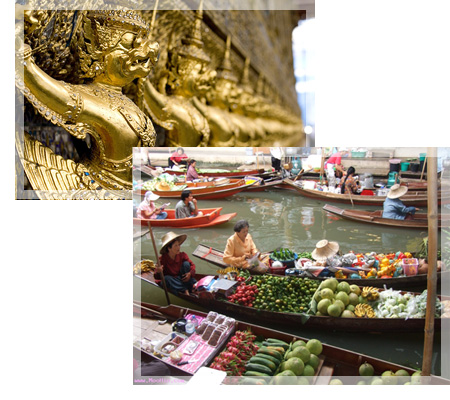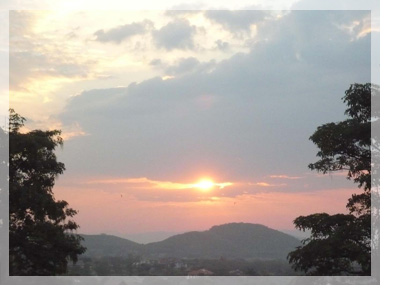| Day 1 Bangkok
In the morning, we will visit the Grand Palace within the precincts of the Temple of the Emerald Buddha, surrounded by high walls enclosing an area of 2 square kilometres. The plan of the Grand Palace follows closely that of the old palace in Ayutthaya. The Palace is rectangular shaped, with the western side next to a river and the royal temple situated to the east side, with all structures facing north. The palace itself is divided into three quarters: the outer quarters (sheltering official offices), the middle quarters (the King’s private area) and the inner quarters (for the female members of the royal family and their intendants). The Temple of the Emerald Buddha (Wat Phra Kaew), boasts a beautiful Jade Buddha statue and is a must for anyone visiting Thailand. Visit of the Throne, State Reception and Coronation Halls. Lunch at leisure.
 Later on, we will discover Wat Phra Chetuphon aka Wat Pho, founded during the 16th century, Ayuthhaya period. Wat Pho’s gigantic Reclining Buddha is 45 metres long, 15 metres high and is covered with tiny golden leaves. It symbolizes the dying Buddha at the very moment he entered the Nirvana. The Reclining Buddha’s most impressive art qualities rest with the mother-of-pearl inlays covering the sole of his feet. They represent legendary symbols by which one can recognize the Buddha. Of the inside wall paintings, remain but the upper parts. Luckily, their beauty has not passed. Later on, we will discover Wat Phra Chetuphon aka Wat Pho, founded during the 16th century, Ayuthhaya period. Wat Pho’s gigantic Reclining Buddha is 45 metres long, 15 metres high and is covered with tiny golden leaves. It symbolizes the dying Buddha at the very moment he entered the Nirvana. The Reclining Buddha’s most impressive art qualities rest with the mother-of-pearl inlays covering the sole of his feet. They represent legendary symbols by which one can recognize the Buddha. Of the inside wall paintings, remain but the upper parts. Luckily, their beauty has not passed.
We will continue along to Vimanmek Palace or Celestial Palace, built in 1901 by King Rama V as a “modest” royal residence. Assembled on Ko Si Chang Island before being moved to the Dusit area in Bangkok, the building has three floors and eighty-one rooms. Take your time and stroll through this splendid palace, the largest building in the world, made of golden teak, entirely assembled with wooden pegs.
Day 1 Damnoen Saduak Floating Market
At 6.30am this morning, we will depart for Damnoen Saduak Floating Market, 80 kilometres away from Bangkok. After being transferred to the pier closest to the market, we will board a long-tail boat and ride through lush vegetation, to the market. En-route, we will have the opportunity to see salt farms and their workers, then we will visit a local and quite authentic floating market crammed with small crafts selling fruit and vegetable as well as an array of delicious dishes and miscellaneous items.
Day 1 Bangkok/Ayutthaya
We will leave at 8.00 am, today to drive to Ayutthaya and visit Wat Phra Nan Choeng on the east bank of the Chao Phraya River, surrounded by a beautiful land, scattered with hedges and shrubs, trimmed into elaborate puddle shapes. Built in 1324, some 26 years before the city of Ayutthaya was officially founded, a massive golden Buddha statue keeps an eye on people coming in. Wat Chai Watthanaram was erected b King Prasat Thong in 1630. Eight smaller prangs are spread around the central one; they are decorated with intricate stucco reliefs showing the Buddha in various situations such as preaching to his mother in the Tavatimsa sky. All prangs have been restored. Wat Yai Chai Mongkol was built by Ayutthaya’s first monarch, King U-Thong in 1347, for the use of monks (known as the Pa Kaeo sect) who had returned from studying in Ceylon. In 1591, King Naresuan proclaimed the independence of Burma and built a huge “Stupa of Victory” to commemorate the event.
 Day 1 Khao Yai Day 1 Khao Yai
Khao Yai National Park is located some 175 kilometres, north-west of Bangkok. Covering an area of more than 2,172 square kilometres of forests, jungles and prairies, the park counts five different zones of distinct vegetation. It is one of the last unspoilt monsoon forests in Asia. More than 153 animal species are sheltered here, among which 200 to 300 wild elephants, some rarely seen black Asian bears, tigers, leopards or barking stags. Exotic birds such as the Calao Bretagne or the Himalayan Bat also live there and are protected by strict regulations.
In Nakhon Nayok Province, en-route to the park, you will stop at a local fruit market and indulge yourself in tasting all sorts of exotic fruits such as mangoes and rambutans, the famous “hairy fruit”, similar to the litchi! Once you have reached Khao Yai National Park, you can take a stroll along well marked-out trails winding through mountains, forests, rivers and waterfalls.
On your way back to Bangkok, you will enjoy a 45-minute elephant ride with a trusted mahout (elephant keeper) through a densely green forest.
Day 1 Kanchanaburi
Some 130 kilometres west of Bangkok, Kanchanaburi Province is a rural area boasting vast sugar cane and pineapple plantations as well as rice paddies; all shades and hues combined bid for some of Thailand’s most breathtaking countryside landscapes.
The infamous Bridge on the River Kwai offers a poignant reminder of the thousands of war prisoners and forced labourers who died there during World War II. Construction of the bridge (1943) was part of a very ambitious war plan devised by the Japanese: it aimed at linking railways from Bangkok (Thailand) to Rangoon (Burma), in an effort to support the Japanese occupation in Burma. We will visit a cemetery with Allies tombs, more often than not a very emotional moment, before proceeding to the JEATH war museum displaying pictures and paintings of that time. We will enjoy a ride aboard the local train before heading back to Bangkok. |

